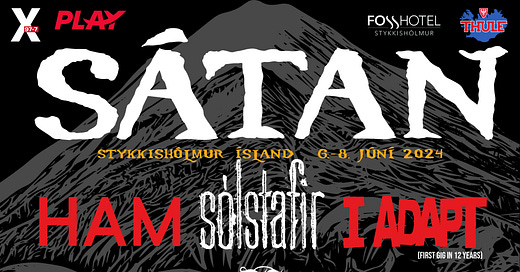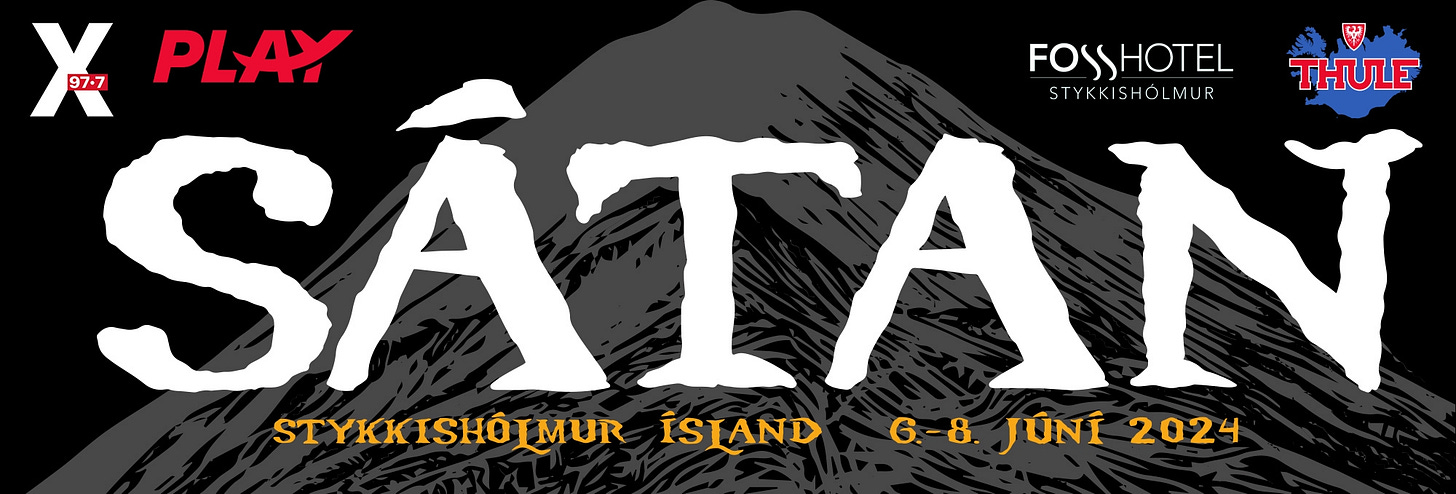Iceland! For most of us, an exotic and outrageously beautiful travel destination, and for those of us with slightly more left-field musical inclinations, also that but a land of unlikely fertility when it comes to new and groundbreaking bands. It might have taken a while for the world - especially the underground/alternative music world - to take notice that there was mother to Iceland than the admittedly already revolutionary Björks or Sigur Rós of this world, but once that little northern blip lit up on our radar, man, the rewards have been plentiful and absolutely constant. You might remember a few of us raving about Eistnaflug, a small festival (or at least it started out like that) in the ass-end of Iceland - no disrespect meant with that expression, for it is in fact a splendidly beautiful ass that all of us who have been there miss dearly -, a little town called Neskaupstaður. That was, for a few years, the place to go for outsiders to feel the pulse of what was happening in the ridiculously talented island (population: 382.000 / cool bands: like a million or so). Sólstafir were already a known name by then, but for people who now have a properly established career like The Vintage Caravan, Misþyrming (plus the whole Icelandic black metal scene that really took off in the last decade), Dimma, Skálmöld or Une Misère, for example, not to mention past greats who have been completely rediscovered by new audiences such as the iconic HAM, they all got a huge boost from the wide-eyed foreigners who descended upon the Eastern Icelandic coast during the golden years of that festival. This also lead to the appearance of several other events around the island (I would like to give Norðanpaunk a shout, it’s still going and it’s absolutely awesome), with varying degrees of success, but now a new thing has appeared which feels like a celebration of that old Eistnaflug spirit - including some of the same people in the organization -, both in terms of the new Icelandic bands that it features, and also in bringing back some of those “old” names we fell in love with back in the day. Ladies, and gentlemen, SÁTAN is upon us.
And by that I mean literally upon us - it’s starting next week already. I usually give you guys a bit more notice with these things, I know, so sorry about that. But I assure you it’s worth a last-minute flight to still get on it if you dig what you see. And what’s not to dig, right? Amazing comebacks of cult Icelandic favourites like Angist and I Adapt, all the Icelandic classics you can wish for like Sólstafir, HAM, Auðn, Naðra,Une Misère or Misþyrming, a whole new batch of new and lesser-known names that’ll surely help carry the magic of this scene for the next decade, plus a few carefully curated cool non-Icelandic names like Arcturus, Blood Red Throne or Wolfbrigade for some familiar headbanging. Also, there’s less traveling involved this time - SÁTAN takes place Stykkishólmur, a town situated in the western part of Iceland, in the northern part of the Snæfellsnes peninsula, much less remote and isolated than the old Eistnaflug used to be, and much easier to get to. Maybe you’ll still get a couple of tourist days out of it too. The setting is surely deserving of it.
After the jump, a little chat we had with Gísli Sigmundsson, one of the organizers, an all-around splendid dude, who used to be in Beneath, is currently a member of Bastarður alongside Addi from Sólstafir, and is also a former member of the super cult Sororicide, which you will surely remember if you are ancient enough to still have been involved in tape trading in the late 80s/early 90s.
Everything else you need to know about the festival can be found here.
“We’ll continue this until we kick the bucket or go bankrupt, whichever comes first! World domination or death!”
- Gísli Sigmundsson
Tell us about the origins of Sátan! How did the idea to do this festival begin, and how did it become eventually a reality? And dude, that name.
Gísli: Well, to be honest it was almost by accident that we started this festival. Me and my wife Nansý were at dinner with our younger daughter Lilja, who lives in Stykkishólmur. We were talking about festivals in general, Nansý and I go to festivals regularly and Lilja was frustrated that some festivals that she was interested in going to, such as Hellfest or Copenhell, were sold out. So, she asked the questions if we couldn’t just have our own festival in Stykkishólmur. I replied that theoretically it was possible but there were a lot of things that would have to fall in place for it to work. We chatted for a while and couple of days later she called us and told us that she had gone to the Stykkishólmur town hall and told them she was going to have a festival in town. She asked us if we were in, and we said yes, although in truth we didn’t really believe that it would ever happen. We were fully expecting someone to say no and put a stop to the plans. However, everyone said yes and a couple of months later we were applying for permits and booking bands and realized that we were going to put on a festival. So, we got some of our friends involved and here we are. Regarding the name, that was also Lilja. There is a small mountain close to Stykkishólmur called Sátan so we thought this was a great idea where we could connect the festival to the town while also knowing that everyone outside of Iceland would read it as something different!
Of course, you guys in the organization are no first-timers at this kind of thing. What lessons do you think you’ve learned in the events that you have put together or helped put together in the past, that you took to Sátan, how do you think your experience improves this festival?
Gísli: I think rather than any specific lessons it’s more an attitude that we’re bringing to this festival that is built on our experience from previous festivals and that is that everyone involved in the festival, staff, bands, and guests should go back home with a smile on their face. We want this to be a fun experience and so we are striving to reach that goal, even if that makes it more work or more expensive for us, we want this to be as good an experience as possible. I’m sure we’ll learn a lot from this first edition and see plenty that we can improve but that is just part of the journey.
There seems to be a healthy mix of some of the more lauded Icelandic artists (which of course you helped get there with your past involvements) but also some newer up and coming names that could be very exciting for the future. Do you have a particular focus in terms of established or younger acts, or is this mix of things actually what you’re going for?
Gísli: We are actually going for the mix. The idea is that Sátan being an Icelandic festival we want to put the focus on Icelandic bands, although there will always be some international bands as well, and we see Sátan as a kind of celebration of Icelandic metal and hardcore bands. So we want both the more established acts and the up and coming as we want to also show how the Icelandic scene has been, and is still, growing with more and more really good new bands emerging.
About the non-Icelandic names, there also seems to be a big mix of styles. What do you see as your basic common denominator for all them? Metal? Heavy? Alternative? Or just plain cool?
Gísli: We definitely see them as all cool! But it is also intentional to mix up the styles as we want to embrace the whole spectrum of metal (and for this purpose we’ve included hardcore as well). So, we’ve kind of created a box for us to play in and while we want to stay within our box, we want to cover it as well as we can. But this also means that, unlike many other metal festivals in Iceland, we’re not straying outside of our box by adding any indie, electronica or alternative bands to the lineup.
Having people like Sólstafir or HAM, which were staples of the old Eistnaflug festival, or the return of Angist, for example, which were so promising a decade ago but then kinda faded away in inactivity, and people like Misþyrming or Naðra, which were there at the beginning of the boom of Icelandic black metal popularity in the 2010s, gives this bill an almost celebratory nature, like bringing back what feels like the golden age of Icelandic heavy music. Did you also go for a bit of that nostalgia?
Gísli: In a way yes. We want to try to get bands that haven’t been active for some time like Angist or I Adapt, and people seem very excited about that. The rest of the bands you mention just make sense to me as they are such stables of the Icelandic scene. But we also need to spread it out as we will not have bands playing two years in a row, which is something that we haven’t seen at other Icelandic festivals yet. So we want to try to keep it interesting with a mix of the big bands, the new up and coming bands and then the surprises of bands coming back after a long time.
Tell us a bit more about Stykkishólmur – what can visiting fans expect from the place?
Gísli: Stykkishólmur is a very beautiful town about two hours driver from Reykjavík. It’s fairly small, only around 1300 people, so we’ll probably take over the town during that weekend. As I said earlier, our daughter Lilja lives in Stykkishólmur which is why we ended up there, but it is very convenient for a festival with how everything is located around the venue. We really hope that visitors will take some time to explore the town and the surroundings as this is a very beautiful area of Iceland.
What about the venue(s) where it will take place, would you like to lay out the structure you have planned? You have 24 bands for 3 days, which is not that much compared to some other events, with 8 bands per day. Is that purposefully done to create a chill atmosphere where people don’t have to run everywhere and miss bands and stuff like that?
Gísli: The festival will take place in the local sports hall, so we’ll have a proper setup there. But as you say, it’s only eight bands per day, only one stage, and we wanted to make sure all the bands would have a chance to put on a proper show. Also, we wanted to make sure people would have time to enjoy themselves and that we weren’t overextending us. We’re completely open to expanding this at some point in the future but it just needs to make sense for us to do it.
Since you’re talking about the future of Sátan, is it safe to assume you’re expecting this to become a regular fixture in the Icelandic calendar?
Gísli: Yes, absolutely! The plan is for Sátan to be an annual event and we’ve already started planning for 2025. We’ll continue this until we kick the bucket or go bankrupt, whichever comes first! World domination or death!







